
Tillandsia is a genus of around 650 species of evergreen, perennial flowering plants in the family Bromeliaceae, native to the forests, mountains and deserts of the Neotropics, from northern Mexico and the southeastern United States to Mesoamerica and the Caribbean to central Argentina. Their leaves, more or less silvery in color, are covered with specialized cells (trichomes) capable of rapidly absorbing water that gathers on them.

Billbergia is a genus of flowering plants in the family Bromeliaceae, subfamily Bromelioideae.

Aeonium arboreum, the tree aeonium, tree houseleek, or Irish rose, is a succulent, subtropical subshrub in the flowering plant family Crassulaceae.

Aechmea bromeliifolia is a bromeliad native to southern Mexico, Central America, Trinidad, and South America as far south as northern Argentina.
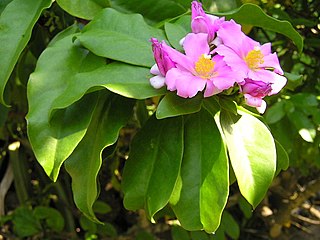
Rhodocactus grandifolius is a species of cactus native to eastern and southern Brazil. Like all species in the genus Rhodocactus and unlike most cacti, it has persistent leaves. It was first described in 1819. It is grown as an ornamental plant and has naturalized outside its native range.

Portea is a genus in the plant family Bromeliaceae, subfamily Bromelioideae. It is native to the Atlantic coast of Brazil.

Cotyledon orbiculata, commonly known as pig's ear or round-leafed navel-wort, is a South African succulent plant belonging to the genus Cotyledon.

Dictyosperma is a monotypic genus of flowering plant in the palm family found in the Mascarene Islands in the Indian Ocean. The sole species, Dictyosperma album, is widely cultivated in the tropics but has been farmed to near extinction in its native habitat. It is commonly called princess palm or hurricane palm, the latter owing to its ability to withstand strong winds by easily shedding leaves. It is closely related to, and resembles, palms in the genus Archontophoenix. The genus is named from two Greek words meaning "net" and "seed" and the epithet is Latin for "white", the common color of the crownshaft at the top of the trunk.
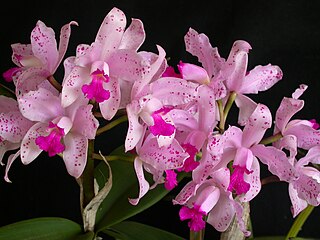
Cattleya amethystoglossa is a bifoliate species of orchid from the genus Cattleya.

Claytonia megarhiza is a species of wildflower in the family Montiaceae known by the common names fell-fields claytonia and alpine springbeauty. The specific epithet megarhiza is Greek for "large roots".

Quesnelia testudo is a species of bromeliad in the genus Quesnelia.

Portea kermesina ('kermesina'=crimson) is a plant species in the genus Portea in the bromeliad family.

Alcantarea imperialis is a species of bromeliad in the genus Alcantarea. This species is endemic to Brazil.
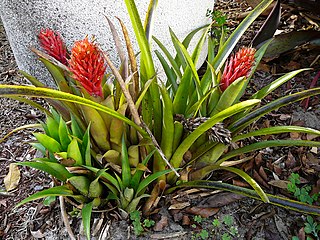
Quesnelia arvensis is a species of bromeliad in the genus Quesnelia.

Vriesea hieroglyphica is a plant species in the genus Vriesea.
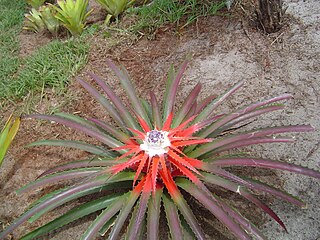
Bromelia balansae is a plant species in the genus Bromelia. This species is native to Argentina, Brazil, Colombia, Bolivia, and Paraguay where it grows at elevations of 150 to 3,000 feet.

Tillandsia schiedeana is a species of flowering plant in the genus Tillandsia. It was named for the collector Christian Julius Wilhelm Schiede. As an epiphyte, it is found "growing in open tropical forests, and saxicolous, growing on cacti and burseras on steep dry slopes in semiarid regions in Mexico, Central America, West Indies, Venezuela, and Colombia at elevations of 750 to 5,500 feet."
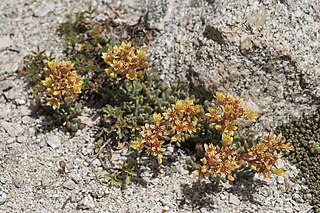
Sedum obtusatum is a species of flowering plant in the family Crassulaceae known by the common name Sierra stonecrop. It is native to the Sierra Nevada and adjacent high mountain ranges of California, its distribution extending north into Oregon and east into Nevada. It grows in rocky mountain habitat.
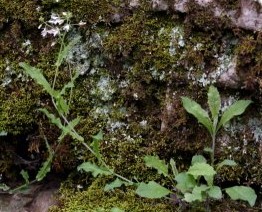
Borodinia perstellata, commonly known as Braun's rockcress and Nevada rockcress, is a rare species of flowering plant in the mustard family. It is native to Kentucky and Tennessee, where it is known from perhaps 25 total populations. Most of the occurrences have few individuals, and all are deteriorating in quality. The plant grows in shady forest habitat on limestone substrates, usually near streams or rivers. This is a federally listed endangered species of the United States.

Echeveria agavoides, or 'lipstick' echeveria, is a species of succulent flowering plant of the stonecrop (sedum) family Crassulaceae, native to the rocky canyons and arid hillsides of Central Mexico. It is primarily known from the states of Aguascalientes, Durango, Guanajuato, Hidalgo, Jalisco, Querétaro, San Luis Potosí and Zacatecas, though it has been sighted as far north as Coahuila and as far south as Oaxaca.





















